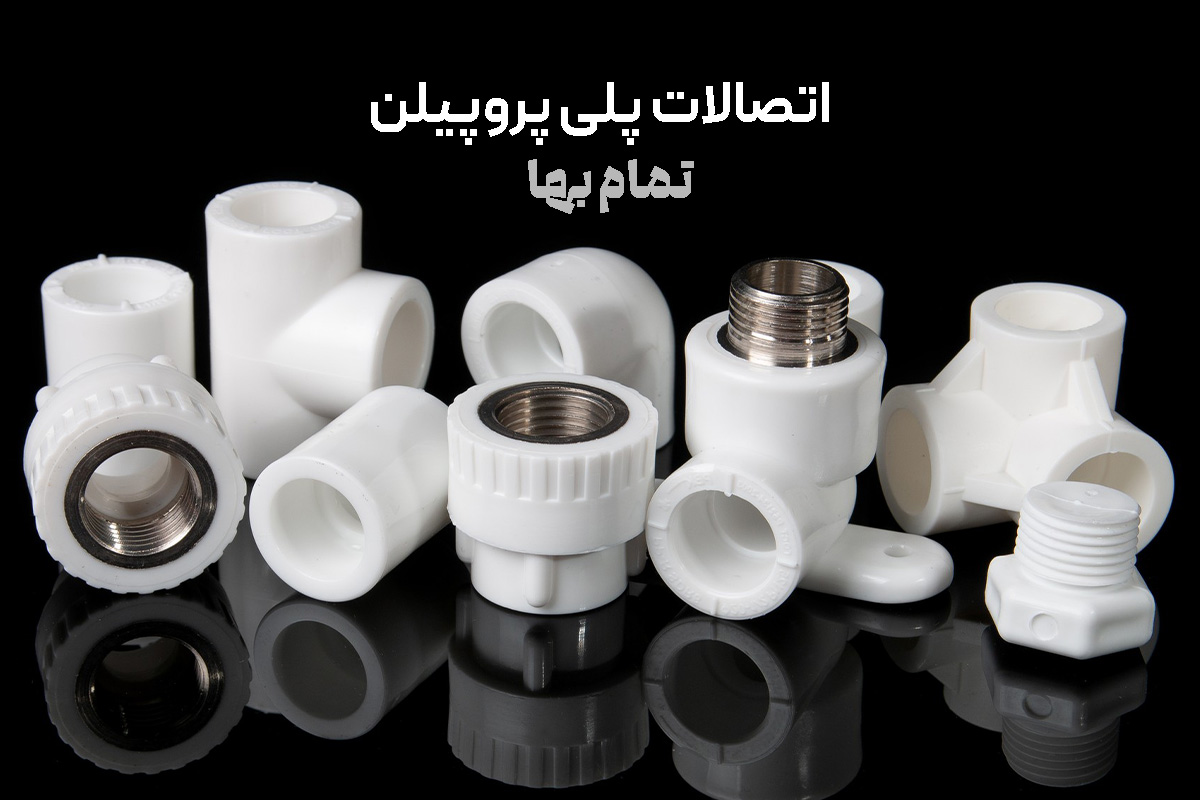Polypropylene fittings are a new generation of high-pressure piping components that, by leveraging the unique properties of the polymer—including low density, chemical resistance, and long service life—have become a durable and economical replacement for metal, brass, and even polyethylene fittings in water supply networks, heating, ventilation, and process industries. The growing use of these fittings is driven not only by technical advantages, but also by new requirements in drinking-water hygiene, energy optimization, and environmental standards.
Molecular Structure and Common Polypropylene Grades
Polypropylene is a thermoplastic polymer with a semi-crystalline chain, and depending on the polymerization method it is produced in four main grades: PP-H, PP-B, PP-R, and PP-RCT. Each grade offers a different ratio of isotacticity, melt flow index (MFI), and thermal resistance; PP-R and PP-RCT, due to their random structure and modified crystallinity, are the first choice for high-pressure hot-water networks.
| Grade | Thermal Resistance (°C) | Chemical Resistance | Flexibility | Key Application |
|---|---|---|---|---|
| PP-H | 95 | Very high | Medium | Industrial process lines, transfer of dilute acids and bases |
| PP-B | 80 | High | High | Multilayer pipes, low-noise sewage systems |
| PP-R | 95–100 | Very high | Excellent | Building cold and hot water, HVAC, radiators |
| PP-RCT | 100+ | Very high | Excellent | Underfloor heating, high-temperature boiler rooms |
Manufacturing, Inspection, and Quality Control
PP fittings are produced by melt injection into water-cooled steel molds. Uniform temperature in the barrel and mold ensures that internal voids and local stresses are minimized. After demolding, parts undergo a hydrostatic test at 1.5× the nominal pressure, an impact test at 0 °C, and a crystallinity test (DSC) to ensure the purity of the polymer grade. For welded fittings, the internal diameter must have a maximum tolerance of ±0.2 mm relative to the matching pipe diameter to prevent burr ingress during fusion.
Technical and Economic Advantages Compared to Other Materials
The key factor behind PP’s popularity over metal and polyethylene is the combination of high tensile strength with low weight. The table below shows an excerpt comparing these three groups:
| Property | Polypropylene (PP) | Polyethylene (PE80/100) | Galvanized Steel |
|---|---|---|---|
| Density (g/cm³) | 0.9 | 0.95 | 7.8 |
| Thermal conductivity (W/m·K) | 0.24 | 0.42 | 50 |
| Pressure rating at 20 °C (bar) | 25 (PN25) | 16 (PN16) | Thickness-dependent |
| Design life (years) | 50 | 50 | 25 |
| Corrosion | None | None | Present |
| Installation speed | Very fast | Fast | Slow |
Complete Range of Fittings and Their Specific Applications
- 45° and 90° socket-weld elbows: direction change with minimal pressure drop; diameters 20 to 160 mm.
- Equal and reducing tees: same-size or reducing branches; the main option for hot-water subnetworks.
- Straight and reducing couplings (sockets): inline splicing to replace damaged sections without rerouting.
- Metal-insert female threaded couplings: threaded connection of brass valves to PP networks.
- PP ball and gate valves: full flow control with PTFE sealing; resistant to scaling.
- PP–iron flange adaptors: transition to cast-iron or steel pipes at pump stations.
Standards and Design Codes
PP systems are designed based on defined temperature classes in recognized standards (ISO 15874 classes 1 to 5 and DIN 8077/8078). Selecting the correct class—for example, Class 2 with a 70 °C maximum temperature—determines the wall thickness and nominal pressure of pipes and fittings. A linear expansion coefficient of 0.15 mm/m·K requires the use of expansion loops or fixed risers for lengths over 6 m.
Joining Methods and Execution Considerations
Socket-Fusion
- Heating element temperature 260 ± 10 °C
- Heating time 5 s for 20 mm diameter up to 24 s for 110 mm
- Insertion depth 1.5 × pipe diameter
Butt-Fusion
- Suitable for diameters over 160 mm
- Surface pressure 0.15 N/mm² during softening
- Cooling in clamps to prevent ovalization of the cross-section
Electro-Fusion
- Coupling equipped with copper coil and a barcode of welding parameters
- Enables data logging in device memory for project traceability
Mechanical Threaded Joint
- For low-pressure lines or emergency repair
- Can be disassembled without destroying the pipe for periodic inspection

Design, Support, and Maintenance
Horizontal support spacing should not exceed 1.5 m for 20 mm diameter and 4 m for 110 mm. In greenhouse irrigation applications, the use of sliding clamps to reduce thermal stresses is mandatory. PP-RCT underfloor heating systems with 100 m circuits have an oxygen ingress rate below 0.32 g/m³·day and therefore do not damage cast-iron pumps. Visual weld inspection, measuring ovality to confirm full melt penetration, and a 24-hour pressure test at 1.3× working pressure are the three pillars ensuring a 50-year service life.
Pricing Factors and Economic Evaluation
- Nominal diameter and pressure class (PN16, PN20, PN25); each higher class increases price by approximately 12% per nominal size step.
- UV stabilizers and anti-scale masterbatches; about a 6% share of the final price.
- Metal content in composite fittings; metal-insert couplings are on average twice the price of all-polymer types.
- Fluctuations in the polypropylene index in Southwest Asian markets; each $100 increase drives roughly a 4% price jump.
Tamambaha, as a reputable supplier in pipes and fittings, offers a wide range of polypropylene fittings in various grades and sizes; at the same time, the platform values choice and encourages customers in English-speaking markets to compare quality and price with other trusted brands so every project can select the best option according to its technical needs and budget.






